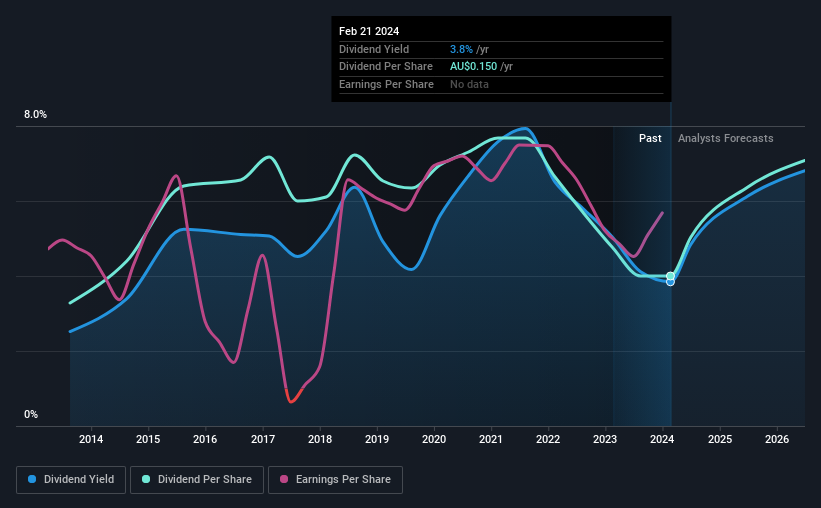Why It Might Not Make Sense To Buy Aurizon Holdings Limited (ASX:AZJ) For Its Upcoming Dividend
Readers hoping to buy Aurizon Holdings Limited (ASX:AZJ) for its dividend will need to make their move shortly, as the stock is about to trade ex-dividend. The ex-dividend date is one business day before the record date, which is the cut-off date for shareholders to be present on the company's books to be eligible for a dividend payment. The ex-dividend date is an important date to be aware of as any purchase of the stock made on or after this date might mean a late settlement that doesn't show on the record date. Accordingly, Aurizon Holdings investors that purchase the stock on or after the 26th of February will not receive the dividend, which will be paid on the 27th of March.
The company's next dividend payment will be AU$0.097 per share, on the back of last year when the company paid a total of AU$0.15 to shareholders. Last year's total dividend payments show that Aurizon Holdings has a trailing yield of 3.8% on the current share price of AU$3.90. If you buy this business for its dividend, you should have an idea of whether Aurizon Holdings's dividend is reliable and sustainable. We need to see whether the dividend is covered by earnings and if it's growing.
View our latest analysis for Aurizon Holdings
Dividends are typically paid out of company income, so if a company pays out more than it earned, its dividend is usually at a higher risk of being cut. It paid out 76% of its earnings as dividends last year, which is not unreasonable, but limits reinvestment in the business and leaves the dividend vulnerable to a business downturn. We'd be worried about the risk of a drop in earnings. A useful secondary check can be to evaluate whether Aurizon Holdings generated enough free cash flow to afford its dividend. Thankfully its dividend payments took up just 48% of the free cash flow it generated, which is a comfortable payout ratio.
It's encouraging to see that the dividend is covered by both profit and cash flow. This generally suggests the dividend is sustainable, as long as earnings don't drop precipitously.
Click here to see the company's payout ratio, plus analyst estimates of its future dividends.
Have Earnings And Dividends Been Growing?
Businesses with shrinking earnings are tricky from a dividend perspective. If business enters a downturn and the dividend is cut, the company could see its value fall precipitously. That's why it's not ideal to see Aurizon Holdings's earnings per share have been shrinking at 3.4% a year over the previous five years.
Another key way to measure a company's dividend prospects is by measuring its historical rate of dividend growth. Aurizon Holdings has delivered 2.0% dividend growth per year on average over the past 10 years. That's interesting, but the combination of a growing dividend despite declining earnings can typically only be achieved by paying out more of the company's profits. This can be valuable for shareholders, but it can't go on forever.
Final Takeaway
Should investors buy Aurizon Holdings for the upcoming dividend? The payout ratios are within a reasonable range, implying the dividend may be sustainable. Declining earnings are a serious concern, however, and could pose a threat to the dividend in future. All things considered, we are not particularly enthused about Aurizon Holdings from a dividend perspective.
If you want to look further into Aurizon Holdings, it's worth knowing the risks this business faces. To help with this, we've discovered 2 warning signs for Aurizon Holdings that you should be aware of before investing in their shares.
Generally, we wouldn't recommend just buying the first dividend stock you see. Here's a curated list of interesting stocks that are strong dividend payers.
Have feedback on this article? Concerned about the content? Get in touch with us directly. Alternatively, email editorial-team (at) simplywallst.com.
This article by Simply Wall St is general in nature. We provide commentary based on historical data and analyst forecasts only using an unbiased methodology and our articles are not intended to be financial advice. It does not constitute a recommendation to buy or sell any stock, and does not take account of your objectives, or your financial situation. We aim to bring you long-term focused analysis driven by fundamental data. Note that our analysis may not factor in the latest price-sensitive company announcements or qualitative material. Simply Wall St has no position in any stocks mentioned.

 Yahoo Finance
Yahoo Finance 
